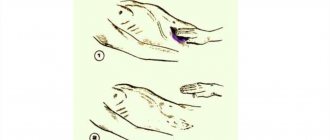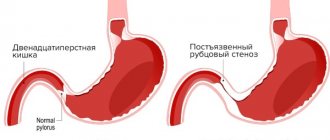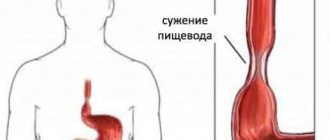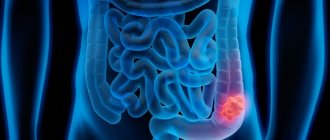General characteristics of the disease
Intestinal obstruction (intussusception) in children is a serious condition in which part of the intestine penetrates (slips, wraps up) into the adjacent part of the intestine, as a result of which the movement of feces through the intestine completely or partially stops. For this reason, the disease is sometimes called “volvulus.” Volvulus in children often blocks the movement of stool and also cuts off blood flow to part of the intestine, which can lead to a tear in the intestine (perforation), infection, and death of intestinal tissue. In severe cases, surgery is required to eliminate the disease.
The complexity of the development and course of the disease depends on in which part of the intestine the obstruction occurs. The disease is most acute if the blockage occurs in the upper part of the intestine.
The disease develops rapidly: the first signs appear within a short period of time and develop very quickly.
Classification
Modern pediatric gastroenterology knows several types of intestinal obstruction in children. According to the nature of origin, the disease is divided into:
- congenital obstruction - occurs as a result of intrauterine pathologies in the development of the gastrointestinal tract in a child, which is why the baby experiences symptoms of the disease from the first days of life. To prevent the recurrence of the disorder, patients are advised to lead an active lifestyle and follow a healthy diet;
- acquired obstruction - the main source of its appearance is intussusception. This form, in turn, is divided into several types. It is diagnosed mainly in infants from the fourth month to one year of life. It differs in that the appearance of symptoms is abrupt and unexpected. In children over 2 years of age, the disease can occur, but is rare.
Acquired intestinal obstruction in children is divided into several types:
- mechanical - occurs due to tumors and fecal stones. In this case, there is a manifestation of severe, cramping pain and disruption of the circulatory process. This may lead to tissue death and peritonitis;
- dynamic - this type of disease develops against the background of previous injuries or operations;
- adhesive - based on the name, the pathology is provoked by the presence of adhesions and inflammation in the abdominal cavity. This is the most common form of this disease in children;
- obstructive;
- strangulation - the main reasons for its appearance are considered to be improper diet, increased intra-abdominal pressure, prolonged fasting, followed by congestion of the stomach.
According to the nature of the spread of the pathogenic process, the disease is divided into several forms:
- complete obstruction - often this type is formed as a result of congenital intestinal obstruction and operations designed to eliminate it;
- partial obstruction - differs in that the intestinal lumen is not completely closed. This type can be quite difficult to detect, which is why therapy begins at a later stage.
According to the nature of its course, intestinal obstruction in newborns and children under 2 years of age is divided into:
- acute - is a consequence of various gastrointestinal disorders, hernias and intestinal tumors. Develops to the terminal stage within 24 hours, which is why medical care should be provided as soon as possible after the onset of symptoms;
- chronic – characterized by a milder course. Children suffer from pain in the lower abdomen and constant constipation. The body gradually becomes exhausted.
Depending on the intussusception, acquired or congenital intestinal obstruction occurs:
- small intestinal;
- colonic;
- small-colic – in which part of the small intestine is introduced into the large intestine.
Types of disease
Blockage of certain parts of the intestine can occur in children of any age, including infants and newborns.
Main types of intestinal obstruction:
- Congenital. This type of disease occurs due to pathologies during the development of the child’s gastrointestinal system. In some cases, at an early stage of intrauterine development, congenital intestinal obstruction develops in the fetus even before birth. As a result, the baby is born with this disease. The course of the disease depends on the degree and level of obstruction. When the level of blockage is high, the newborn vomits bile. A low degree of obstruction is characterized by the presence of stool retention and gag reflexes in the child, which occur a few days after birth.
- Acquired. There are various forms of acquired disease. The most common type of disease is mechanical obstruction (intussusception). Less commonly, intestinal obstruction occurs due to the presence of adhesions. The disease is observed in small children from birth to 1 year. This type of intestinal blockage occurs suddenly and is characterized by acute pain and vomiting. Your baby's stool may contain blood and mucus.
general characteristics
Intestinal obstruction is the result of impaired movement of its contents through the intestinal tract .
The pathological condition is provoked by a deviation in the motor ability of the digestive organs or a mechanical obstacle.
The risk of developing intestinal obstruction can develop gradually (against the background of congenital or acquired diseases of the gastrointestinal tract) or occur suddenly (for example, when a foreign body enters a child’s esophagus).
Features of intestinal obstruction:
- the pathological process can be acute or chronic;
- blockage of the intestinal lumen can be complete or partial;
- obstruction may occur in the area of the small intestine or the bauhinian valve.
Causes of the disease
In the vast majority of cases, the cause of intussusception in children is unknown. Since intussusception occurs more often in the autumn-winter period and in many children intussusception occurs during acute respiratory viral infections, a number of scientists associate intestinal obstruction with the effects of viruses that cause these acute respiratory viral infections.
Intestinal obstruction can also occur if the following factors are present:
- Congenital intestinal pathology;
- Inflammation of internal organs;
- Volvulus of any part of the intestine;
- Violations of the structure of the pelvic organs;
- Penetration of a foreign body into the intestine;
- Adhesions, hernias;
- Benign tumors;
- Roundworms and other parasites;
- Petrified feces;
- Gallstones.
Risk factors
Risk factors for intussusception include:
- Age. Children—especially young children—are much more likely to develop intussusception than adults. Intestinal obstruction is most often diagnosed in children aged 6 months to 3 years.
- Floor. Invasion most often affects boys.
- Abnormal formation of the intestinal tract. Intestinal malrotation is a condition in which the intestine does not develop or fold correctly, and this increases the risk of intussusception.
- History of intussusception. If a child has already had intussusception once, he or she is at increased risk of developing the condition again. Invasion recurs in more than 10% of patients.
- Family history. If there is a history of intussusception in the family, the child has an increased risk of this disease.
Classification of the disease
Intestinal obstruction can be congenital or acquired. In the first case, the disease is provoked by abnormalities in the digestive tract system , which begin to develop in the child even at the stage of intrauterine formation of the body.
In the second case, intestinal obstruction is caused by certain factors that have a negative effect on the baby’s digestive organs after birth.
Classification of intestinal obstruction depending on the mechanism of development:
- mechanical type (presence of obstacles partially or completely blocking the intestinal lumen);
- strangulation type (congenital pathology of the mesentery);
- dynamic type (impaired intestinal motility).
In medical practice, the development of intestinal obstruction is divided into three stages . The initial stage lasts several hours and is accompanied by flatulence combined with pain in the abdomen.
The second stage of the disease is characterized by a decrease in symptoms, but the relief is temporary. At this stage, a powerful intoxication of the baby’s body occurs, which can progress over several days. The third (thermal) stage develops in the form of an attack.
Signs and diagnosis of the disease in children
How to determine that a child has a volvulus? There are several signs. The most important one is:
Cramping pain. The first sign of an intestinal obstruction in a baby may be sudden, loud crying caused by abdominal pain. Babies under one year old with abdominal pain may pull their knees toward their chest when they cry. The pain comes and goes, usually every 15 to 20 minutes. Over time, these painful episodes last longer and occur more frequently;
Other common signs and symptoms of intestinal obstruction include:
- Lack of appetite, refusal to eat;
- Bloating (flatulence);
- Nausea and vomiting;
- Retention of stool;
- Lump in the abdominal cavity;
- Difficulty or absent stool;
- In some cases, diarrhea is possible;
- Temperature increase;
- The presence of bloody discharge and mucus in the stool, visually similar to “currant jelly”;
- Lethargy.
Not all children have all of these symptoms. Some children do not have blood in their stool or a lump in their abdomen. Some older children have no symptoms other than pain.
Invasion requires emergency medical care. If your child develops the signs or symptoms listed above, get medical help right away.
Remember that in young children (up to one year old), signs of abdominal pain may include periodic drawing of the knees to the chest and crying.
Important! If a child experiences severe abdominal pain, it is necessary to urgently seek medical help. Intestinal obstruction in the vast majority of cases is accompanied by abdominal pain of varying intensity.
If a child experiences the above symptoms, parents should immediately contact a surgeon or pediatrician. The doctor will conduct diagnostics, make a diagnosis and prescribe treatment that will correspond to the child’s age and the severity of the disease.
These symptoms are similar to other diseases such as appendicitis.
We also recommend reading the article: “Signs of appendicitis in children: main symptoms of different ages.”
Possible complications
An intestinal obstruction can cut off blood flow to the affected part of the intestine. If this condition is left untreated, the lack of blood causes tissue in the intestinal wall to die, and it can also lead to a tear (perforation) in the intestinal wall, which can cause an infection in the abdomen (peritonitis).
Diagnosis of the disease
Be prepared to provide full information to your doctor on the following questions:
- When did your child start experiencing stomach pain or other symptoms?
- Is the pain continuous or intermittent?
- Does the pain start and end suddenly?
- Has your child experienced nausea, vomiting or diarrhea?
- Have you noticed blood in your baby's stool?
- Have you noticed any swelling or swelling in your baby's abdomen?
To confirm the diagnosis, the doctor may prescribe:
- Ultrasound or other diagnostic imaging procedure of the abdominal organs. An ultrasound, X-ray, or computed tomography (CT) scan may reveal an intestinal obstruction. The results of the obtained images, as a rule, show a “bull’s-eye”, which is the intestine rolled up in intussusception. Abdominal imaging can also show if the intestine has been ruptured (perforated).
- Air or barium enema. An air or barium enema enhances visualization of the colon. During the procedure, the doctor will insert air or liquid barium into the colon through the rectum. In addition, an air or barium enema can in many cases correct the intussusception itself, in which case no further treatment is required. A barium enema cannot be used if there is an intestinal rupture (perforation).
Diagnostics
Two specialists are involved in the diagnosis of intestinal obstruction - a pediatrician and a surgeon . If it is necessary or difficult to identify the disease, other specialized doctors may be involved.
Suspicion of intestinal obstruction in a child may arise based on his general examination and medical history. To confirm the diagnosis, laboratory research methods and additional procedures are required.
Diagnostics is carried out using the following methods:
- X-ray of the abdominal organs;
- General and biochemical analysis of blood and urine;
- laparoscopy;
- CT or MRI of the abdominal cavity;
- air or barium enema;
- Ultrasound of the abdominal organs.
Treatment of illness in a baby
If you notice signs of intestinal obstruction in a child, do not give him food or medicine until he has been examined by a doctor.
Important! If a child develops symptoms of intestinal obstruction, urgent hospitalization is necessary. Self-medication can lead to complications and serious consequences.
Emergency medical attention is required to avoid dehydration and severe shock, and to prevent infection that can occur when part of the intestine dies due to lack of blood.
The baby is examined for the presence of intestinal disease by a surgeon. If complications occur, surgical intervention is necessary.
To treat intestinal obstruction, your doctor may prescribe:
- Air enema or barium enema. It is both a diagnostic procedure and a treatment. If the enema works, further treatment is usually not required. This procedure is very effective in children.
- Surgery. If the intestines rupture or enemas fail to straighten the intestines, surgery is necessary. The surgeon will release the part of the intestine that has become twisted, remove the blockage (obstruction), and, if necessary, remove dead intestinal tissue.
If the intestinal disease is not in an acute, advanced stage, conservative therapy is prescribed. It consists of a set of procedures to remove stagnant feces from the intestines and cleanse the body of harmful substances and toxins.
The following procedures may also be prescribed to your baby:
- To stop the vomiting process, the stomach is lavaged through a special tube;
- Medicines are administered intravenously that help restore water-salt balance;
- Antiemetic, analgesic and antispasmodic medications;
- If treatment is successful, the baby may be prescribed the medicine proserin, which stimulates proper intestinal activity.
Symptoms of intestinal obstruction
Symptoms of intestinal obstruction in children appear suddenly and develop quite quickly. The disease has both a general clinical picture and some features depending on the age group.
Are common
The main clinical manifestations of the pathology are the following:
- Pain syndrome. Unpleasant sensations are cramping and colicky in nature, intensifying when peristalsis occurs; the child is capricious, cries, cannot find a comfortable position.
- Nausea, retching. Vomiting is not profuse and does not bring relief; its frequency depends on the severity of the disease and the affected part (a greater number of urges is observed when the pathological focus is localized in the small intestine).
- Constipation. Lack of stool passage occurs for more than several days. The indication for enema is high intestinal obstruction; When the pathological focus is localized in the thick section, it is impossible to achieve fecal release using this method. In addition to constipation, the child is worried about flatulence.
If these clinical manifestations occur in a child, you need to consult a doctor as soon as possible, since this surgical pathology threatens a large number of complications, and death is not excluded.
In newborns
In addition to the general manifestations, congenital intestinal obstruction has the following symptoms:
- bloating;
- no release of gases;
- delayed passage of stool in infants;
- frequent vomiting mixed with bile.
Congenital intestinal obstruction with damage to small parts, occurring in an obstructive form, has such a sign as “rectal spitting” - the release of a lump of mucus instead of stool during defecation. It does not contain cells that are swallowed by the child in utero with amniotic fluid. Normally, such impurities are present in the baby’s original feces.
The cause of intestinal obstruction in children in the first 12 months of their life is intussusception, which develops as a result of immaturity and insufficient functioning of the digestive system. This is facilitated by such factors as the sudden introduction of complementary foods, the change from natural feeding to artificial feeding, and infectious diseases of the digestive system.
The main manifestations of intussusception:
- intense cramping pain in the abdomen;
- the suddenness of the onset of pain, so children can suddenly cry out, worry, or cry;
- frequent vomiting;
- passing a lump of mucus mixed with blood instead of stool;
- increased gas formation;
- compaction in the area of the abdomen where intussusception occurred.
With the development of intussusception in the thick part of the digestive tract, there may be a complete absence of stool passage.
In children older than one year
Symptoms of intestinal obstruction in children after 12 months are distinguished by the following features:
- suddenness of the disease;
- by a sharp deterioration in the child’s well-being, parents can tell the exact time of the onset of the pathology;
- visible bloating due to lack of passage of stool and gases;
- children cannot find a comfortable position, rush about, cry;
- painful urge to defecate;
- When the inner layer of the intestine is damaged, slight bleeding is observed.
A characteristic sign of intestinal obstruction at this age is Val's symptom - asymmetry of the abdomen associated with the accumulation of feces and gases above the area where the obstruction occurred, which do not pass further through the intestines.
Manifestations at different stages of development
Intestinal obstruction occurs in three stages: “Ileus cry”, intoxication, terminal. Symptoms characteristic of each stage will be discussed in the table.
| Stage | Time period of development | Clinical picture |
| Stage 1 (Ileus Scream stage) | First 12 hours |
|
| Stage 2 (intoxication stage) | After the first day |
|
| Stage 3 (terminal stage) | Second or third day |
|
Prevention of recurrence of the disease
After eliminating the causes and symptoms of intestinal obstruction, the child should follow a diet for some time. The child's diet should contain only those foods that have a positive effect on the intestinal microflora.
The diet is aimed at eliminating putrefactive processes and fermentation in the gastrointestinal tract.
Basic rules for feeding a baby after an illness.
- Food products that contribute to the formation of gases should be excluded;
- The daily menu should consist of low-fat broths, steamed meat, pureed dishes;
- The child should not be given sweets, starchy foods, as well as salty and fried foods;
- The baby should be given rosehip decoction and green tea at least twice a day;
- In summer, it is recommended to include fruit jelly, compotes and fruit drinks in a child’s diet;
- The child should consume fermented milk products daily.
If the diet is not followed, every second child ends up in the hospital again with a relapse of the disease.
Intestinal obstruction in young children can occur in different forms. It is very important to consult a specialist in time and begin treatment to avoid complications.
Be healthy!
High intestinal obstruction
High intestinal obstruction (HIO) mainly includes obstruction of the duodenum, the cause of which can be malformations of the duodenum itself ( atresia, membrane
), and the organs and vessels surrounding the duodenum (
ring-shaped pancreas, preduodenal portal vein, aberrant vessels compressing the duodenum ).
The diagnosis of duodenal obstruction can almost always be made during antenatal examination already at 14-20 weeks of pregnancy. Ultrasound reveals a “double bubble” – a pathognomonic symptom of duodenal obstruction.
Fig.7. Antenatal diagnosis of duodenal obstruction (“double bubble”).
VCI is an absolutely correctable pathology, the surgical treatment of which in itself does not present any particular difficulties. However, 25-40% of patients with VCH have Down syndrome, and if duodenal obstruction is combined with heart disease, then this figure exceeds 80%. Thus, if, if the fetus has duodenal obstruction, future parents are interested in the child, then before giving advice to continue the pregnancy, it is necessary to perform cordocentesis and karyotyping, especially in cases where duodenal obstruction is combined with a heart defect.
When antenatally diagnosing VKN, immediately after the birth of the child it is necessary to probe and empty the stomach, and transfer the newborn to a specialized hospital.
If the diagnosis of VCN was not made antenatally, then after birth the leading symptom of this pathology is vomiting and regurgitation. Depending on the level of duodenum obstruction, vomiting may be with or without bile. If the obstruction is located above the nipple of Vater, then the vomit will not contain bile, but meconium will be expelled, since it is formed from the products of bile processing, which in this case is released into the “outflow” colon. If the obstruction is localized below the nipple of Vater, then the vomit contains bile, and only clear mucus can leave the rectum. The diagnosis in the first case can be difficult due to the absence of the usual “attributes” of any intestinal obstruction (stool passes, no “stagnant” contents in the stomach). Therefore, for timely diagnosis, it is necessary to pay attention not only to regurgitation and vomiting, but also to other symptoms. In particular, children with VCI, as a rule, are born either premature (average gestation period 33-34 weeks) or hypotrophic - body weight (BW) in full-term children rarely exceeds 2500 g. When examined, all children with VCI attract attention sunken belly. In some patients, the epigastric region may periodically be “done,” however, after regurgitation or vomiting, the anterior abdominal wall collapses again. In all patients, jaundice appears early and rapidly progresses, the cause of which is a violation of the conjugation of bilirubin in the liver and an increase in hemoconcentration; there is also a rapid loss of body weight - the average daily loss can reach 5-7% of BW. Thus, the following symptoms in newborns should make the doctor suspect congenital duodenal intestinal obstruction: vomiting and regurgitation syndrome, sunken abdomen, progressive weight loss, prenatal malnutrition, prematurity, early-onset and rapidly increasing jaundice.
The main diagnostic method for suspected high intestinal obstruction is an x-ray examination, which begins with survey x-rays in a vertical position in two projections. The typical radiographic symptom of “complete” high CI (duodenal atresia) is the presence of two gas bubbles with fluid levels (double bubble sign) and the absence of gas in the underlying intestine. This X-ray picture absolutely reliably confirms the diagnosis of VCI, and therefore no additional research methods (including the use of contrast agents) are required (Fig. 8).
Fig.8. Picture of complete duodenal obstruction (two levels of liquid and gas in the stomach and duodenum).
With duodenal stenosis or a membrane with a hole (partial duodenal obstruction), radiographs sometimes show a small amount of gas distal to the duodenum, while the characteristic radiological sign of duodenal obstruction (double bubble sign) may be absent. In this case, it is necessary to perform a contrast study and, first of all, to exclude malrotation syndrome, which radiographically and clinically may resemble partial duodenal obstruction. However, with malrotation (as opposed to malformations of the duodenum itself), life-threatening complications caused by midgut volvulus can develop if the diagnosis is not timely. Therefore, after survey radiographs, irrigography is performed in a direct projection to determine the position of the colon in the abdominal cavity. For irrigography in newborns, we use a 25-30% solution of verografin, which is prepared immediately before the examination by diluting 2.5-3 times with a 76% solution of a contrast agent. To fill the entire colon in full-term newborns (the first days of life), 45-60 ml of contrast agent is sufficient, in premature infants - 25-30 ml (at the rate of approximately 15-20 ml per kg of body weight).
Intestinal obstruction in children - how to identify and respond to a dangerous condition?
Parents often encounter abdominal pain in their children. As a rule, unpleasant sensations quickly pass after a light massage, but you should not be too careless about them. If symptoms occur frequently, it may be intestinal obstruction in children - a serious problem that requires treatment.
Classification of intestinal obstruction in children
There are different types of disease. Intestinal obstruction in children is classified as follows:
- Dynamic.
It develops due to a slowdown in regional mesenteric circulation and changes in the central nervous system, which is responsible for the functionality of the gastrointestinal tract. - Adhesive.
Such intestinal obstruction in children becomes a consequence of disorders caused by adhesions in the abdominal cavity. This form of the disease is considered the most common. - Congenital.
This is a consequence of pathologies in the development of the gastrointestinal tract. Congenital obstruction can sometimes develop in the womb. - Acquired.
It is usually observed in children from 4 to 5 months to a year. - Spicy.
A very dangerous type of illness. If acute intestinal obstruction in children is not treated in any way, this can lead to tragic consequences. - Full.
Such obstruction also poses a danger to the baby’s life. When sick, feces cannot leave the body at all for various reasons. - Partial.
Partial intestinal obstruction in children occurs as follows: the intestinal lumen does not close completely, and feces can pass out, but they do so very slowly. - Chronic.
It develops when suspicious symptoms are ignored for a long period of time. - Strangulation.
This intestinal obstruction in children is characterized by twisting of the intestine around the longitudinal axis. - Obstructive.
With this type of disease, the contents of the intestine move with difficulty, but compression of the mesentery is not observed.
Causes of intestinal obstruction in children
Acquired, chronic, congenital intestinal obstruction in children can develop for various reasons. As a rule, the disease appears due to:
- volvulus;
- adhesions;
- intussusception;
- hernias;
- diverticula;
- disturbances in the structure of internal organs;
- parasites;
- mobile cecum;
- disturbances in the structure of internal organs;
- penetration of foreign objects into the gastrointestinal tract;
- inflammatory processes.
Congenital intestinal obstruction in children
A number of factors can cause congenital intestinal obstruction syndrome in children. Among them:
- intestinal stenosis or atresia;
- enterocystoma;
- ring-shaped pancreas;
- Hirschsprung's disease and other malformations of the intestinal walls;
- Ladd's syndrome;
- midgut volvulus.
Acquired intestinal obstruction in children
This form of the disease often develops against the background of atony or a sharp decrease in intestinal motility, which subsequently leads to stagnation of feces. In most cases, such intestinal obstruction occurs in children over the age of 4 months. In addition, the disease can be caused by certain developmental defects or blockage of the intestines by parasites.
Intestinal obstruction - symptoms in children
Each type of disease has its own symptoms, but there are signs of intestinal obstruction in children that are the same for all types of illness. These include:
- Pain.
It has a cramping character. Contractions should coincide with the peristaltic rhythm. During an attack of intestinal obstruction, the child demonstrates symptoms very clearly. Because of this, the pain sometimes becomes so severe that the baby may even develop pain shock. - Vomit.
If the problem affects the small intestine, then vomiting can be repeated and profuse. There is no relief. With lesions of the large intestine, the urge is usually rare or completely absent. - Stool retention and problems with passing gas.
If the colon is obstructed, there may be no gas for several days. When the small intestine is affected, this phenomenon is classified as a late sign.
Partial intestinal obstruction in children
With this form of the disease, the process of movement of feces slows down in a separate section of the intestinal tract. This happens due to partial blockage of the lumen. That is, part of the feces comes out as liquid stool. Such intestinal obstruction symptoms in children under one year of age and older have the following:
- nausea;
- pain;
- bloating.
The main signs of intestinal obstruction in children:
- abdominal asymmetry;
- flatulence (accompanied by an increase in the size of the abdomen);
- complete absence of stool;
- symptoms of intoxication (pallor, weakness, lethargy, fever).
Why is intestinal obstruction dangerous?
This problem needs to be addressed as soon as possible. Otherwise, dynamic intestinal obstruction in children can cause dangerous complications that pose a real threat to life:
- Peritonitis.
It begins against the background of perforation of the intestinal walls and the development of infection. Inflammation in the abdominal cavity can lead to sepsis. - Necrosis of the affected area of the organ.
If the blood flow to a certain area of the intestine stops, tissue death will begin, which can cause perforation of the walls and release of contents into the abdominal cavity.
Intestinal obstruction - what to do?
At the first suspicious symptoms, it is advisable to seek qualified help. If intestinal obstruction is diagnosed, treatment is prescribed by a specialist. Self-medication is highly undesirable and can be dangerous. Therapy depends on the form, degree of neglect of the disease, the age of the patient, the characteristics of his body, and the state of the immune system.
Intestinal obstruction - first aid
To improve your child’s well-being as soon as possible, you need to know the basic rules for providing first aid for a problem such as adhesive intestinal obstruction in children. Under no circumstances should you give your child laxatives or give cleansing enemas. Not only will they not bring relief, but they will also worsen the condition.
If the diagnosis is confirmed, in most cases the little patient is hospitalized, and before doctors arrive, the following should be done:
- Measure pressure and temperature.
- Check your pulse and monitor your heartbeat.
- Provide the baby with complete rest.
- Give him small amounts of water regularly.
Frequent and severe abdominal pain in a child is a reason to consult a doctor. Moreover, it is advisable to do this as soon as possible in order to start treatment on time and prevent complications.
For diseases such as adhesive obstruction in children, clinical recommendations vary. Both conservative and surgical treatment are allowed.
The choice of method is influenced by factors such as timing of treatment, form of obstruction, and others.
Surgical intervention is usually required for congenital and adhesive types of the disease. In the most severe cases, the intestine has to be removed to the front of the peritoneum.
If you are late in going to the hospital and necrotic processes begin to develop, you need to remove part of the intestine.
Patients with peritonitis are additionally prescribed painkillers, antibiotics, vitamins, and restoratives.
Conservative therapy is prescribed upon early consultation with doctors. Treatment consists of pumping air into the intestines and straightening the intussusception. To make sure that the intestines are functioning correctly, the child is left under the supervision of specialists in a hospital for several days. Excess air is removed through a gas outlet tube in the rectum.
In case of obstruction caused by helminthic infestation, conservative therapy is also first indicated, but if the spasm is not relieved, the ball of parasites has to be moved along the intestine mechanically through the opened abdominal cavity. In the most severe cases, the helminths have to be removed directly from the dissected intestine. The intestinal walls are then sutured.
To combat dynamic obstruction, a number of such measures are carried out:
- compensation for potassium deficiency;
- stimulation of peristalsis;
- electrical stimulation of the intestine;
- reducing the load on the gastrointestinal tract.
Source: https://womanadvice.ru/kishechnaya-neprohodimost-u-detey-kak-opredelit-i-reagirovat-na-opasnoe-sostoyanie
Treatment
For congenital intestinal obstruction, surgical intervention is indicated. An important point is preoperative preparation, the specifics of which depend on the type of obstruction, duration of the disease and severity of homeostasis disorders, and the age of the child. The nature of the surgical intervention is determined by the anatomical variant of the malformation (straightening of the volvulus, separation of adhesions, bowel resection, duodenojejunostomy and other operations). The prognosis depends on the severity of the defect and associated anomalies, timely diagnosis, the effectiveness of preoperative preparation and intensive postoperative therapy. All children operated on for congenital intestinal obstruction require clinical observation with correction of feeding and treatment of dysbiosis, anemia, malnutrition, and enzyme deficiency.
Bychkov V.A., Manzhos P.I., Bachu M. Rafik H., Gorodova A.V.
Published by Konstantin Mokanov
Intestinal obstruction in children: symptoms, causes and effective treatments
When should you see a doctor?, Symptoms and treatment
Intestinal obstruction is a pathology in which there is a disruption in the movement of previously eaten food into the gastrointestinal tract with complete or partial blockage of the stool exit route.
The disease is most often congenital, but sometimes it is acquired. Intestinal obstruction in children can occur in utero in 25% of cases.
Accounts for 1.5-9% of all diseases localized in the abdominal cavity and 3-5% of cases of visits to surgical departments.
Authors: Doctor of Medical Sciences, Prof. Klimenko Victoria Anatolevna,
Candidate of Medical Sciences, Associate Professor Yanovskaya Ekaterina Aleksandrovna
Classification
If intestinal obstruction in children is considered, the classification takes into account many points.
Depending on the development mechanism:
- Dynamic intestinal obstruction in children appears if the regulation of motor skills is disturbed, it can be: spastic (intestinal spasm occurs) paralytic (peristalsis completely disappears).
- Mechanical - an obstacle is created in the intestine, which prevents the passage of its contents. This type is divided into the following subtypes: strangulation - the intestine, its mesentery, nerves and blood vessels are compressed; obstructive - develops as a result of blocking the intestinal lumen due to various reasons (worms, fecal stones); mixed - there are signs of strangulation and obstruction (examples of this type are intussusception and adhesive intestinal obstruction in children).
Depending on the level at which the obstruction occurred:
- high (small intestine);
- low (colon).
By the nature of obstruction - partial and complete.
By origin:
- congenital intestinal obstruction in children;
- acquired.
With the flow:
- acute - develops in case of complete intestinal obstruction;
- chronic - occurs if the intestines are not partially passable, with this form there are periods of exacerbation and remission;
- recurrent - symptoms are not constant, the disease is intermittent.
Causes
Since there are congenital and acquired intestinal obstruction in children, it is necessary to separately consider the causes of each form of the disease.
The main reasons due to which a congenital disease may occur include:
- developmental anomalies in which part of the intestine is compressed (for example, deformed organs - ring-shaped pancreas, aberrant vessel);
- congenital atresia and intestinal stenosis;
- meconium ileus (small intestinal blockage in young children), in which viscous meconium blocks the intestinal lumen;
- congenital defects that impair the rotation and fixation of the mesentery;
- abnormal development of the intestinal wall (Hirschsprung's disease).
Acquired intestinal obstruction in children occurs for the following reasons:
- formation of adhesions after previous injuries or operations;
- severe helminthic infestation;
- intussusception - the development of the disease occurs if one part of the intestine is introduced into another;
- necrotizing enterocolitis during the neonatal period;
- intestinal neoplasms;
- poisoning with toxins;
- metabolic disorders.
Symptoms
Symptoms of intestinal obstruction in children may differ depending on the form of the disease, but a number of common signs can be identified for each of them.
- An early and persistent symptom of the disease is pain. It can appear suddenly, without any warning, at any time of the day. Sometimes the stomach begins to hurt after intense physical activity or overeating. If the disease occurs due to blockage of the intestines by a tumor, previous signs may appear: periodic bloating, mucus and/or blood in the stool, alternating constipation with diarrhea. Pain in this case occurs without clear localization. Strangulation (arising as a result of compression) acute intestinal obstruction in children is characterized by severe, constant pain, which periodically intensifies to the point of unbearability. A period of imaginary well-being occurs in the case of necrosis of the strangulated area of the intestine - the pain decreases and may even disappear. With paralytic obstruction, the pain is constant, not intense, bursting; with spastic obstruction, it is often paroxysmal, but not intense.
- Retention of stool and gases is a mandatory sign of obstruction. If there is intussusception, you can observe the release of mucus with blood (“raspberry jelly”).
- In 50-60% of cases, vomiting occurs, usually together with nausea. Initially, reflex vomiting of previously eaten food occurs at the height of the pain syndrome. As intoxication progresses, it becomes more abundant and includes intestinal contents.
- Abdominal bloating is uniform or asymmetrical. With high forms of obstruction, the stomach may not swell.
Congenital intestinal obstruction in children:
- depending on the location of the obstacle, it can be low or high;
- by time of occurrence - postnatal and intrauterine;
- according to the severity of the narrowing - partial and complete.
High obstruction occurs in the first hours of life and is characterized by persistent vomiting with an admixture of bile, rapid weight loss, and with complete obstruction (blockage) - the absence of meconium (the first feces of newborns). At the same time, the baby is restless, his stomach is sunken.
If congenital low intestinal obstruction develops, the child's symptoms are slightly different. Immediately you can see pronounced bloating, increased peristalsis, even visually detectable.
Vomiting is not so frequent, stagnant in nature, with an unpleasant odor.
If congenital intestinal obstruction is suspected, the newborn should be urgently transferred to a specialized surgical department.
Why is intestinal obstruction dangerous for children?
With this problem, children often develop severe disturbances in water and electrolyte balance, leading to dehydration. Since the cells and tissues of the body are very sensitive to any changes in the internal environment, dysfunction of almost all systems and organs may occur.
Intestinal obstruction in children can be complicated by various life-threatening pathological processes, including:
- necrosis of the intestinal wall and its further perforation;
- peritonitis;
- sepsis.
To prevent the risk of complications, at the slightest suspicion of obstruction, it is important to immediately consult a doctor.
Diagnostic measures
Congenital intestinal obstruction in children requires diagnosis in the maternity hospital. It includes:
- assessment of medical history: polyhydramnios, pathological course of pregnancy;
- assessment of the general condition of the newborn: large physiological weight loss, signs of intoxication, high hematocrit and hemoglobin;
- palpation of the abdomen;
- rectal examination - no meconium;
- probing the stomach to assess its contents.
If the diagnosis is confirmed, the baby is urgently transferred to a surgical hospital, where an X-ray examination is performed to examine the level of the obstacle.
Acquired intestinal obstruction in children requires the following techniques:
- survey of the child or parents: find out complaints, time of onset of the disease and its development, characteristics of the body in a particular case;
- examination - allows you to assess the general condition, detect bloating, localization of pain, the nature of stool and vomit, the condition of other systems;
- laboratory diagnostics: general clinical tests of urine, blood;
- instrumental techniques: radiography, ultrasound of the abdominal organs.
In difficult cases, laparoscopy may be necessary for diagnosis.
Treatment and diet
Treatment of intestinal obstruction in children includes the following:
- if this pathology is suspected, hospitalization in a surgical hospital is indicated;
- Until the diagnosis is finally established, laxatives should not be taken, enemas and gastric lavage are excluded;
- treatment can be conservative and surgical.
The treatment method is selected depending on the form of the disease and the timing of contacting a doctor. For congenital intestinal obstruction, meconium ileus, and pyloric stenosis, surgical treatment is indicated.
If adhesive intestinal obstruction occurs in children, surgical intervention is required. This is the most dangerous form of the disease. Sometimes it becomes necessary to remove the intestine onto the abdominal wall.
If intestinal necrosis develops, in case of late treatment, the affected area is removed during surgery. If peritonitis occurs, complex treatment is indicated using detoxification drugs, antibiotics, restorative drugs, painkillers, and symptomatic medications.
Acute intestinal obstruction in children that occurs during intussusception, subject to early access to qualified medical help, is treated conservatively.
Air is pumped into the intestines with a special apparatus, and under X-ray control they try to straighten the intussusception. After this procedure, the baby is observed for some time in the hospital.
Subsequently, an X-ray is taken using a barium suspension.
In case of intestinal obstruction caused by worms, they first try to treat it conservatively. If such therapy is ineffective, surgery is performed.
Dynamic intestinal obstruction in children is treated conservatively: the cause that caused it is eliminated.
Diet
To restore health after illness, dietary nutrition is indicated. You need to eat in small portions and often. Baking, bread, dairy products, legumes, cabbage, sweet, fatty and salty foods are excluded from the diet.
Recommended foods are steamed, low-fat, and high in coarse fiber. It is not advisable to eat fresh vegetables and fruits. From drinks you can drink herbal decoctions, weak green tea, water, jelly. Sodas, sweets and cold drinks should be excluded.
The concept of a pathological process
Intestinal obstruction in children is one of the serious pathologies. This process is usually understood as a violation in the pushing of chyme through the lumen of the digestive tract. In newborns and infants up to one year old, the disease is characterized by severe pain, spasms and the urge to vomit. Intestinal obstruction can only be eliminated through surgery. Older children are prescribed conservative therapy and diet.
Intestinal atresia is a blockage or fusion of the lumen of the digestive tract. The complexity and degree of development of the disease depends on the location of the organ damage. The higher the contamination, the more severe the pathology will be. The main feature of the disease is the rapid onset of the first symptoms. But timely consultation with a doctor and properly prescribed treatment can avoid serious problems.









